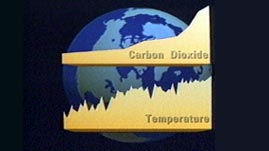Scientific evidence has convinced most experts that global warming is a reality. Since the start of the Industrial Revolution in 1880, the average temperature of the planet has increased by slightly more than one degree Fahrenheit to its present level of about 60°F. This seemingly insignificant change represents a fairly rapid warming trend. According to the UN-sanctioned Intergovernmental Panel on Climate Change, by the end of the twenty-first century Earth's inhabitants will be facing temperatures that are at least three degrees Fahrenheit warmer, and possibly as much as ten.
An understanding of global warming is based on understanding why our planet is warm in the first place. As the Sun's energy reaches Earth's surface, some of it is reflected back into space and some of it is absorbed. The absorbed energy warms Earth's surface, which, in turn, radiates heat back toward space as infrared radiation. Among the collection of molecules that forms our atmosphere, certain gases -- known as greenhouse gases -- absorb some of the outgoing energy and radiate some of it back to Earth.
When the planet radiates energy back into space at the same rate that it receives energy, it remains at a fixed temperature. However, if gases in the atmosphere prevent energy from escaping into space, the planet will radiate less energy and warm up -- until it reaches the temperature at which it again radiates just enough energy to keep the temperature stable. The more greenhouse gases the atmosphere contains, the warmer the planet becomes before it reaches the point where it radiates all the energy it receives and the temperature again stabilizes.
For most of Earth's 4.6-billion-year history, greenhouse gas concentrations and global temperatures have followed a complex pattern of ups and downs, as our planet has cycled through warm periods and ice ages. For the past nine thousand years, however, Earth's temperatures have been unusually stable. Since the beginning of the Industrial Revolution, however, that stability has been disrupted.
The most important greenhouse gases are water vapor (H
2O), carbon dioxide (CO
2), methane (CH
4), and nitrous oxide (N
2O), all of which are naturally occurring. However, human activities are sending ever-increasing amounts of greenhouse gases into the atmosphere: burning wood and fossil fuels such as gas, coal, and oil adds carbon dioxide; livestock and coal production add methane; and agricultural and industrial processes add nitrous oxide. Oceans and land plants are only able to absorb half of the increased amount of greenhouse gases; the rest accumulates in the atmosphere, where it strengthens the greenhouse effect, and thus contributes to global warming.

 Loading Standards
Loading Standards Teachers' Domain is proud to be a Pathways portal to the National Science Digital Library.
Teachers' Domain is proud to be a Pathways portal to the National Science Digital Library.
